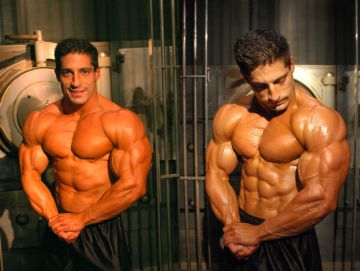Broken Chest
Broken Chest – I used to envy the guys who could hit a few sets of push ups and achieve pectoral development twice as good as I could by pressing a ton of weight. This intensified when they couldn’t offer a single bit of advice as to how I could progress in that region, but I couldn’t blame them.
They didn’t need it! Throughout my weightlifting and bodybuilding career, no single bodypart has been more difficult to stimulate into new growth than my chest. This has led to much frustration given that I’ve always desired a thickly muscled pec region more than any other bodypart.sbobet88
Initially, I sprung out of the skin and bone phase by building the outer portion of my chest. From there, I learned how to position the body to tap into the fiber moving toward the inner region of the lower pecs, making my weak upper chest stand out more. sbobet88
A year or two, and a pair of over-developed front delts later, I finally learned how to bring that up…but even then, my battle was only half over. It was almost as if God was playing a decade-long prank on me! www.mrchensjackson.com

Up until just recently, no fan of bodybuilding had ever complimented my chest. Surely I have more work to do, but I’m certain that I have finally devised a formula that works incredibly well.
I am going to share some very effective tips that you can apply to boost your progress in this area. Because I basically had to piece my chest together, the years of research, trial and error, and meticulous thought that I’ve devoted to build this area is going to be of great benefit to you! And who better to get them from than someone who built it from scratch!
Form is everything when it comes to stimulating the chest region! The first sign that something is wrong with your form will surface when you can achieve a pump in some bodyparts, but not others. Knowing this, if you achieve a better pump in your front delt region than you do in your chest, you have not yet formed the essential mind-muscle connection.
Practically speaking, making an effort to flex and feel the chest on a frequent basis will enhance your mind-muscle connection and boost your capability to fall into the practice of sound form when performing chest movements. Until I could effortlessly flex and feel a sharp contraction in the upper, inner, and lower region of my chest, I could not stimulate it, with all of effort going into the outer fiber of my chest and front delts.
I can state with absolute certainty that you will never maximize your potential until you can feel your chest working when performing chest movements, and this is especially true for those like myself that are not genetically blessed with dense fiber in that region.
This often entails overlooking the irrational fear of using a lighter weight until you feel it more in the chest. If you are brave enough to do so, I will bet my bottom dollar that it will respond much more and the thorough pump that you will attain, from the inner to outer and upper to lower pectoral region, will prove it to you!
The body is meant to work as a unit, and while this can be used to create a beneficial synergy on occasion, it is also the cause of inadequate chest stimulation and over-usage of the front delts when performing chest movements.
A generic model to recruit chest fiber when pressing for mass and power involves arching your lower back slightly, expanding the ribcage, and squeezing the shoulders down and back against the bench.
Watch an NFL lineman force an opponent or go and put yourself in position to push something with all of your might. In both cases, you will observe that the body naturally falls into this position.
If you were to keep the shoulders down and back when performing every chest movement, in time you would notice that the inner region, near the sternum, would appear under-developed. Anatomically, that particular position pulls the humerus back and stretches the chest from its origination on the sternum, which is ideal for generating the most power and for overall mass building.
Conversely, you can work the chest with reaching-like movements, bringing the shoulders forward and the arms across the body through the top half of the ROM. Doing so will generate a super-strong contraction and shift emphasis toward the inner fibers, aiding toward the maximization of shape and detail in that region.
To achieve thorough development, both form variations must be incorporated in your regimen on a consistent basis. A very basic model would be to divide each chest workout by ROM.
This means working the first half or three-quarters of the ROM with presses, with the shoulders rolled back, and following that up by working the top half with cable flys and machine movements, where the shoulders come forward as the arms reach across the body.
Once you grasp the basic mind-muscle connection and form concepts, you simply need to select the appropriate pieces of equipment and begin construction. Given that many great champions profess the usage of one apparatus over another, this can lead to a great deal of confusion.
I have given this quite a bit of thought, and in part 2 of this series (Tool Chest) I am going to help you select the right tools for the job!
